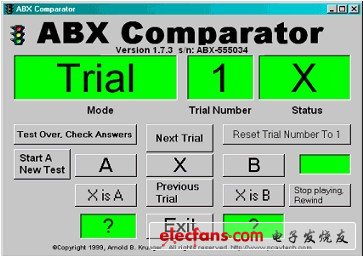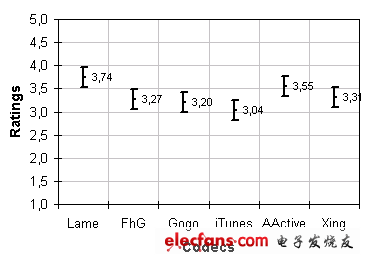People usually listen to music, and various factors affect our actual listening experience. These factors include cables, speakers and even the software decoder itself. So how can we tell whether these factors bring about positive or negative effects? The ABX test can bring us answers. The ABX test is a common method used in audio applications to measure or compare non-quantifiable characteristics (such as sound quality) between objects of the same nature. Since there are only two choices, either A or B, there is a 50% chance of choosing the right one, so a simple test does not explain the problem. Statistical analysis is required, that is, more than one test is required. The usual practice generally requires the tester to redo a test 15 times, and each test will randomly select one from both A and B as X. According to the analysis of all test results, the possibility of accidentally choosing the right one can be greatly reduced. From the probability point of view, the probability of choosing the right one test is 50%, and the probability of choosing the right one after repeated 16 tests is 50% of the 16th power, which is one part of 65536. In other words, if the difference between A and B is very small and the tester cannot hear the difference at all, the average result of the tester should be a value that tends to 50%. If there is a clear difference between A and B, the average result of the test person should have a clear tendency. For example, we need to compare the sound quality of two pairs of speakers. Obviously, they should have different performances. After we have conducted the test 7 times, there will be a 128% chance of obtaining a false correct answer, that is, the summary result obtained after the statistics based on the test results is wrong compared with the actual situation. Statistically, this situation is called "the first type of error." The probability of this type of error decreases as the number of tests increases, and for each increase in the number of tests, the probability of an error decreases by one-half. . Now, we put a bracelet next to the CD player and then test it. It can be said that this should have no effect on the sound quality. We repeated the test 40 times, and the probability of successfully distinguishing the sound quality was 2 to 1/40. It can be said that the chance of error is very small. However, if the test results prove that there is a difference in sound quality between putting on and not putting on the bracelet, there must be an explanation: it may be that the test person heard the operator make a sound when moving or putting down the bracelet; or every time the bracelet is placed on the player The operator's movements will slow down when he is nearby; or other various non-audible factors may cause such a result. Regarding statistical matters, it is estimated that no one is interested in in-depth discussion, so stop here. But from the above simple explanation, we can distill some rules for the ABX blind listening test: 1. It is impossible to verify things that do not actually exist. If you have a question about something, such as thinking that an audio codec will affect the sound quality, you should verify it by testing, not take it for granted based on any assumptions. 2. The test should be conducted under double-blind conditions. The single-blind test means that you cannot tell whether X is A or B unless you actually listen. Double-blind testing means that neither the operator nor the tester knows whether X is A or B during the test, to avoid possible intentional or unintentional operator hints. That is, a third person is required to be responsible for switching. There are quite a few softwares on the computer that can perform ABX testing. 3. Make sure that the tester only knows the results after the test is completed, including the experimental tests that may be performed before the formal test. Otherwise, the tester should know the result after each test and can decide to abort the test at any time. 4. The test must be conducted for the first time. If not, the results of all previous tests should be considered together. 5. The tester can reserve opinions, that is, during the testing process, they can reserve opinions when they are not sure about their own judgments, and request a suspension, to be continued later. 6. The test process must be reproducible, and the test results obtained according to the same test process should also be consistent. 7. Timing during testing is also an aspect to consider. For example, in the continuous testing process, the same time interval should be given to avoid the tester's judgment being influenced by different timing and making guesses. Of course, the test results are not necessarily as simple as "X is A" or "X is B". For example, in the sound quality test of MP3 encoding, the tester also needs to select the similarity of X to A and B, and then calculate the sound quality effect of MP3 encoding. This can also be extended to other test methods. The following figure is a graph of the ABX test results on the comparison of the sound quality of different MP3 encoders. 12V Battery Pack,Dewalt 14.4 Volt Battery,Tile With Replaceable Battery,Dewalt 20V Lithium Ion Battery Zhejiang Xinghai Energy Technology Co.,Ltd , https://www.headwayli-battery.com
In this test, the tester will get three audio sources labeled A, B, and X, respectively. A and B are for reference. One of them is processed and the other is unprocessed. For example, one is the original WAV file and the other is the mp3 file compressed from the WAV file. X is an unknown sound source. It may be A or B. The tester must listen to compare whether it is A or B. The picture on the right is the interface of a typical ABX test software. 